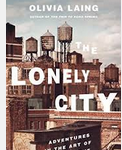The loss of a love affair, and the subsequent plunge from being one of a pair to living alone, provide the impetus for Olivia Laing’s collection of thought-provoking essays mixed with incisive memoir exploring art, singularity, and New York City. Laing quotes Dennis Wilson’s line “Loneliness is a very special place” as she starts her exploration of what it means to be lonely and, as she puts it, her “attempt to chart the complex relationship between loneliness and art.” Others have written about the feeling of loneliness; Laing, instead, examines her feelings through the visual arts, and the lives of several artists.
Laing begins with Edward Hopper, focusing in particular on his painting “Nighthawks.” Four people, alone and yet together, are seen through a curved glass window. Laing asks, “Was the diner a refuge for the isolated, place of succour, or did it serve to illustrate the disconnection that proliferates in cities? The painting’s brilliance derived from its instability, its refusal to commit.” From there Laing discusses psychologists’ descriptions of loneliness, from temporary to extreme and intractable emotional isolation – and the difficulty the unlonely have in relating to a lonely person’s efforts to reach out for company. We are made uneasy by and blame the lonely for their isolation, she says. Then Laing points out that perhaps we know instinctively what she reports modern research has discovered: “loneliness drives up blood pressure, accelerates aging, weakens the immune system, and acts as a precursor to cognitive decline . . . it can prove fatal.”
After the chapter on Hopper, which spends too much time discrediting his long marriage and ignores his Cape Cod paintings, Laing moves on to the work and lives of Andy Warhol, David Wojnarowicz, the outsider artist Henry Dargis, and then, starting with a discussion of the singer Klaus Nomi, circles back to Wojnarowicz, Warhol, and the impact of the AIDS epidemic on late 20th century New York. The lives were difficult, and Laing’s descriptions are unsparing, especially the chapter on Dargis, a thrown-away human being: both his parents were dead by the time he was eight; he was raised in a the Illinois Asylum for Feeble-Minded Children; he lived alone and worked as a janitor, until, at the age of 80, he became too ill to care for himself and moved to a nursing home. When his Chicago landlord cleaned out the room Dargis had lived in for 40 years, he found more than 300 paintings “of almost supernatural radiance” and 15,000 manuscript pages describing, in Laing’s words, a “coherent otherworld . . . a place Dargis inhabited far more dynamically and passionately than he did the everyday city of Chicago.”
Since Laing is writing a memoir, and mediating the experience of loss and loneliness through art, it makes sense that for her the art and the life are different sides of the same experience. Some of her insights are compelling. For example, in her sympathetic chapter on Warhol, Laing captures what it’s like to participate in a conversation without quite getting the parameters right, something most of us outgrow by the end of high school but an experience Warhol continued to suffer throughout his life (he was the child of immigrants).
Either you don’t communicate enough and remain concealed from other people, or you risk rejection by exposing too much altogether: the minor and major hurts, the tedious obsessions, the abscesses and cataracts of need and shame and longing.
Laing could be describing blog comments, Facebook discussions, or Reddit threads with this passage. It’s a measure of her strengths as a writer that Laing is able to translate Warhol’s experience into a universal one that didn’t become obvious until the advent of the Internet, long after Warhol’s 1987 death.
In describing her experience of loss through her experience and interpretation of the work of others Laing is not unusual. What’s different here is that Laing brings her research about the difficult, painful, and yes, lonely lives of her subjects into a close relationship with their art. This has two consequence for the book: first, it can be very hard to read. Some of these lives were painful – Henry Dargis’’ in particular. Second, she asserts that often the work is an attempt to explore and explain a life, and in one sense it may be, but many writers and painters will argue that while the work bears a relationship to the life the work and the life are distinct. At the same time, it’s too easy for her to succumb to a false sense of nostalgia for a New York that existed before she arrived, when Times Square was messy and dirty and full of pornography. Despite its 8,000,000 residents and countless visitors, New York City is still a lonely place, and still a place of great creative ferment. For the moment, though, it’s not a dangerous one.
Have a book you want me to know about? Email me at asbowie@gmail.com. Follow me on Twitter @abowie917.



